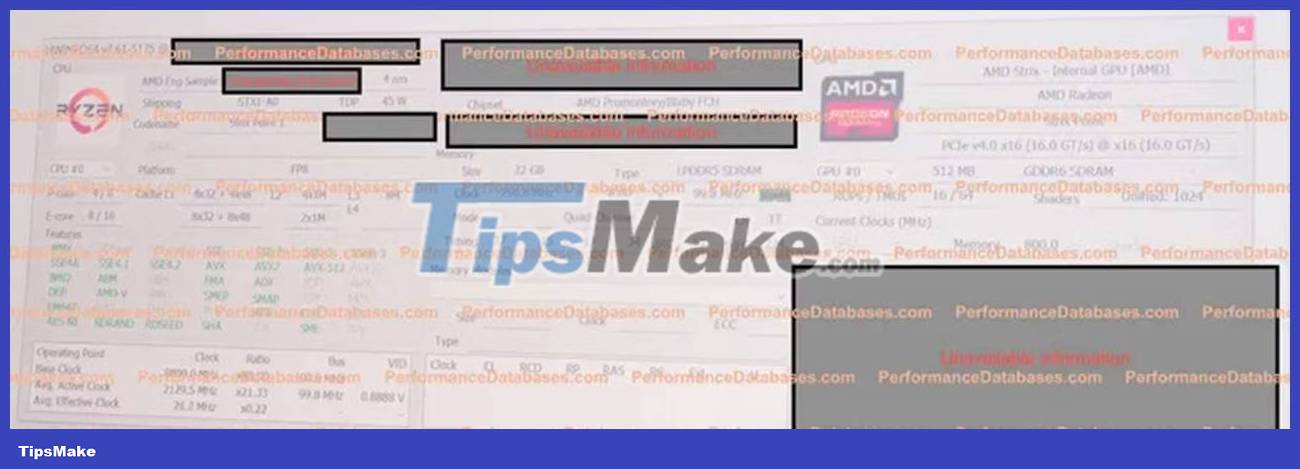What is AMD RDNA 3.5? When will it be released?
As usual, these deliver performance gains that mainly stem from changes in the GPU architecture. AMD has gone all out with RDNA 3 introduced in its RX 7000 series of GPUs. However, considering the huge leap Nvidia made with Ada Lovelace on the RTX 40-Series GPUs, AMD's upcoming RDNA 3.5 has some major problems to overcome.
What is AMD RDNA 3.5?
While AMD is tight-lipped about specifics, RDNA 3.5 is a new GPU architecture that sits between RDNA 3, AMD's Ada Lovelace competitor, and the upcoming RDNA 4. It will most likely be used as an integrated GPU (iGPU) solution for mobile APUs for handhelds and laptops. Accelerated processors combine the CPU and GPU into a single chip for efficiency and other benefits.
 What is AMD RDNA 3.5? When will it be released? Picture 1
What is AMD RDNA 3.5? When will it be released? Picture 1
These next-gen chips will be based on AMD's upcoming Zen 5 architecture (expected in 2024), built on a 4nm process with established performance and efficiency cores. very similar to Intel's design. We may also see updates to AMD's software stack, most notably FSR 3, which is AMD's equivalent of DLSS 3.5.
All available information about RDNA 3.5 suggests that it is AMD's answer to the modern dedicated mobile GPU. Whether we will see a standalone GPU with the RDNA 3.5 architecture remains unknown. That means, if AMD decides to refresh RDNA 3 before RDNA 4 launches, it could be based on RDNA 3.5, so the possibility of a standalone GPU isn't completely ruled out.
When will RDNA 3.5 be released?
Similar to the architecture description, AMD has not yet revealed an official launch date for the RDNA 3.5 architecture. However, since RDNA 3.5 has been confirmed to be part of the Ryzen 8000 Granite Ridge processors and Ryzen 8000 Strix Point APUs, it is expected to launch in 2024. In addition to the two product lines mentioned, there are it is likely that RDNA 3 will be refreshed using the RDNA 3.5 architecture.
AMD usually launches CPUs at CES (Consumer Electronics Show held annually in January) so it's likely that RNDA 3.5 will be introduced to the world in January 2024. Also, it's unknown when AMD will announce the new architecture.
What performance improvements will RDNA 3.5 bring over RDNA 3?
With the limited information currently available, it is difficult to know how RDNA 3.5 will outperform previous generations of RDNA, specifically RDNA 3 and 2. However, we can look at the CPUs and APUs which RDNA 3.5 will launch with to get an idea of how it will work.
HWiNFO screenshot posted on Performance Database details an AMD 8000 series APU with 16 RDNA 3.5 GPU cores and 12 Zen 5 CPU cores in a mixed configuration. Other features include an average processor clock speed of 2.12 GHz along with 32GB of 6400 MHz LPDDR4 RAM and a TDP of 45W.
 What is AMD RDNA 3.5? When will it be released? Picture 2
What is AMD RDNA 3.5? When will it be released? Picture 2
It looks like RDNA 3.5 will make its debut in AMD's mobile APU lineup. This decision makes sense considering what it has accomplished in handheld gaming devices with RDNA 2 and RDNA 3 (for example, with the Steam Deck, Asus ROG Ally, and the upcoming Lenovo Legion Go). The CPU runs on Zen 5, equipped with 16 RDNA 3.5 GPU compute cores, which should theoretically deliver a significant increase in GPU performance compared to its predecessors.
That means the processor is still in engineering sample (ES) state, so it's hard to say whether this performance will hold up in the real world. Additionally, the screenshot also only shows 512MB of GDDR6 video memory, which is almost certainly due to incomplete drivers for the unsupported APU or any other bug on the software side.
One of AMD's biggest advantages over Intel is the integrated RDNA graphics in its processors. Provided RDNA 3.5 lives up to the hype, the GPU architecture could make low-end GPUs obsolete and should help AMD regain some of the market share it lost to Intel.
You should read it
- AMD launches Radeon Pro W5700, the first 7nm GPU for workstations
- AMD launches Ryzen 6000 Series mobile processors with a series of significant improvements in graphics and power efficiency
- Leaked benchmark results of AMD Radeon RX 6700M 'Navi 22' laptop GPU
- Everything you need to know about AMD Zen 5
- Why will Apple launch iPhone 6 on September 12?
- Watch live the first SpaceX spacecraft launch event
- How to add Quick Launch bar in Windows 10
- How to Instantly Launch Apps with Wox on Windows
- Firefox 16 was released again after updating the vulnerability patch
- Live reporting of iPhone 8/8 Plus and iPhone X launch events
- Apple has released iOS 13.1 beta, although iOS 13 has not been officially launched
- MacBook Air 2011 may be released later this week
May be interested

What is the difference between a workstation and a gaming PC?

What CPU temperature is normal? How to stabilize CPU

AMD Ryzen 7 3750H processor and information you need to know

Learn about AMD chip lines? Are they better than Intel chips?

How long is SSD lifespan? How to estimate SSD drive life

Compare chips (CPU) AMD and Intel? What is the best choice?






 AMD Radeon 800M iGPU with 16 RDNA 3.5 cores scores more than 3600 points in 3DMark Time Spy, nearly equal to RTX 2050 Perf
AMD Radeon 800M iGPU with 16 RDNA 3.5 cores scores more than 3600 points in 3DMark Time Spy, nearly equal to RTX 2050 Perf AMD reveals reason for delaying RDNA 4 platform launch
AMD reveals reason for delaying RDNA 4 platform launch RX 9070 XT performance gradually revealed, is it enough to make Nvidia 'fear'?
RX 9070 XT performance gradually revealed, is it enough to make Nvidia 'fear'? AMD launches Radeon Pro W5700, the first 7nm GPU for workstations
AMD launches Radeon Pro W5700, the first 7nm GPU for workstations AMD launches Ryzen 6000 Series mobile processors with a series of significant improvements in graphics and power efficiency
AMD launches Ryzen 6000 Series mobile processors with a series of significant improvements in graphics and power efficiency Just released a few days ago, iOS 14 has been successfully cracked
Just released a few days ago, iOS 14 has been successfully cracked